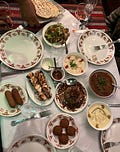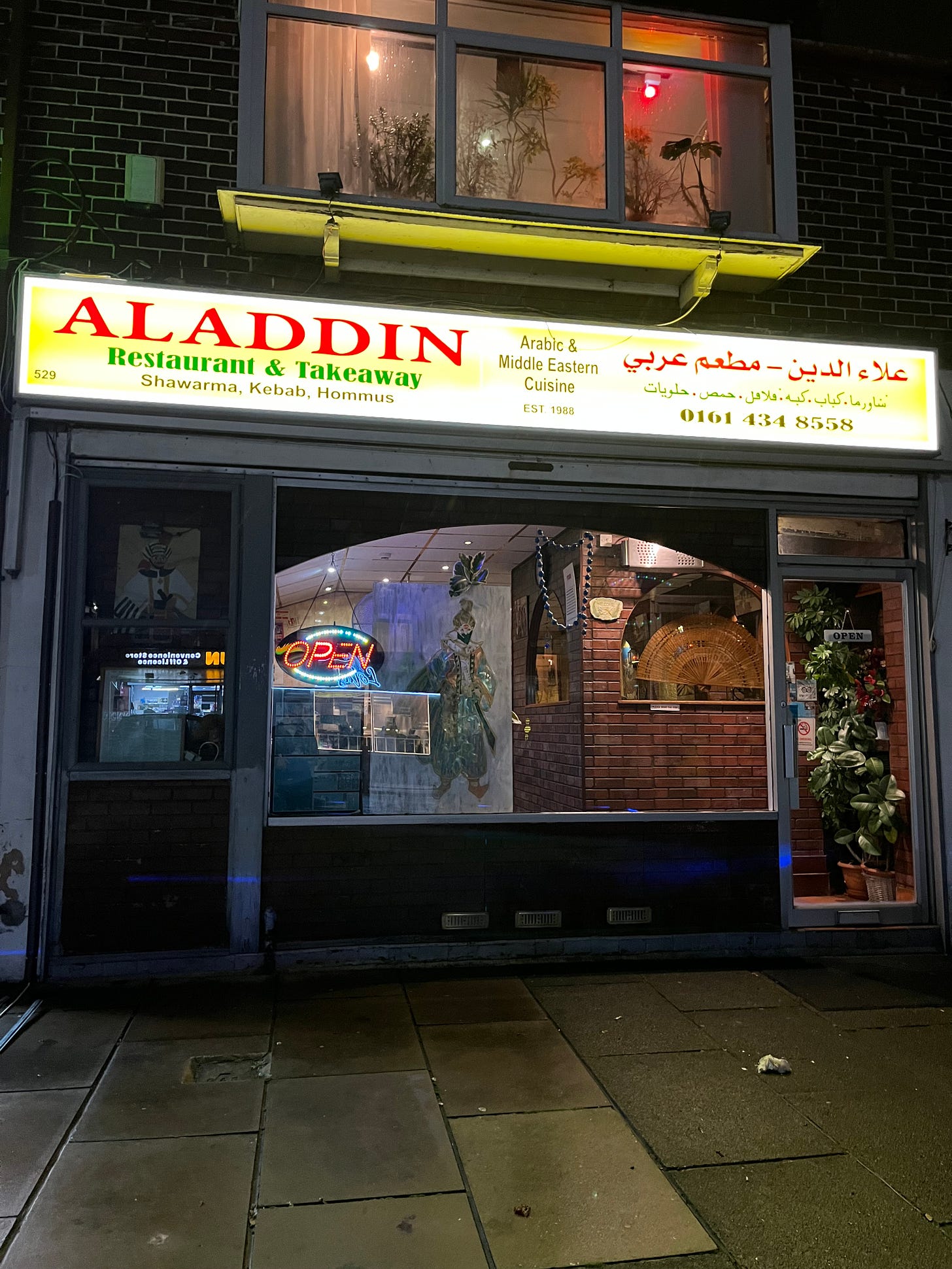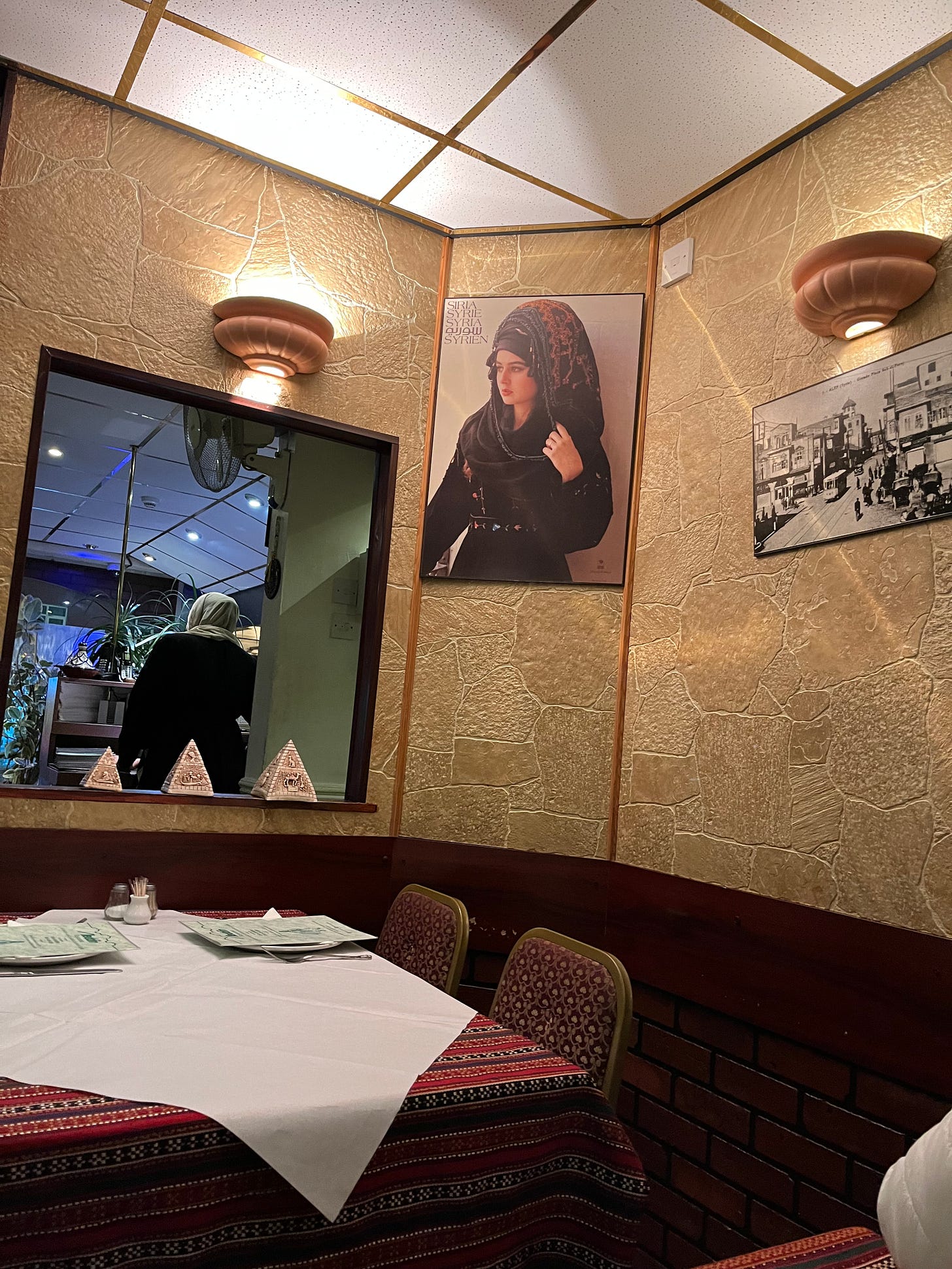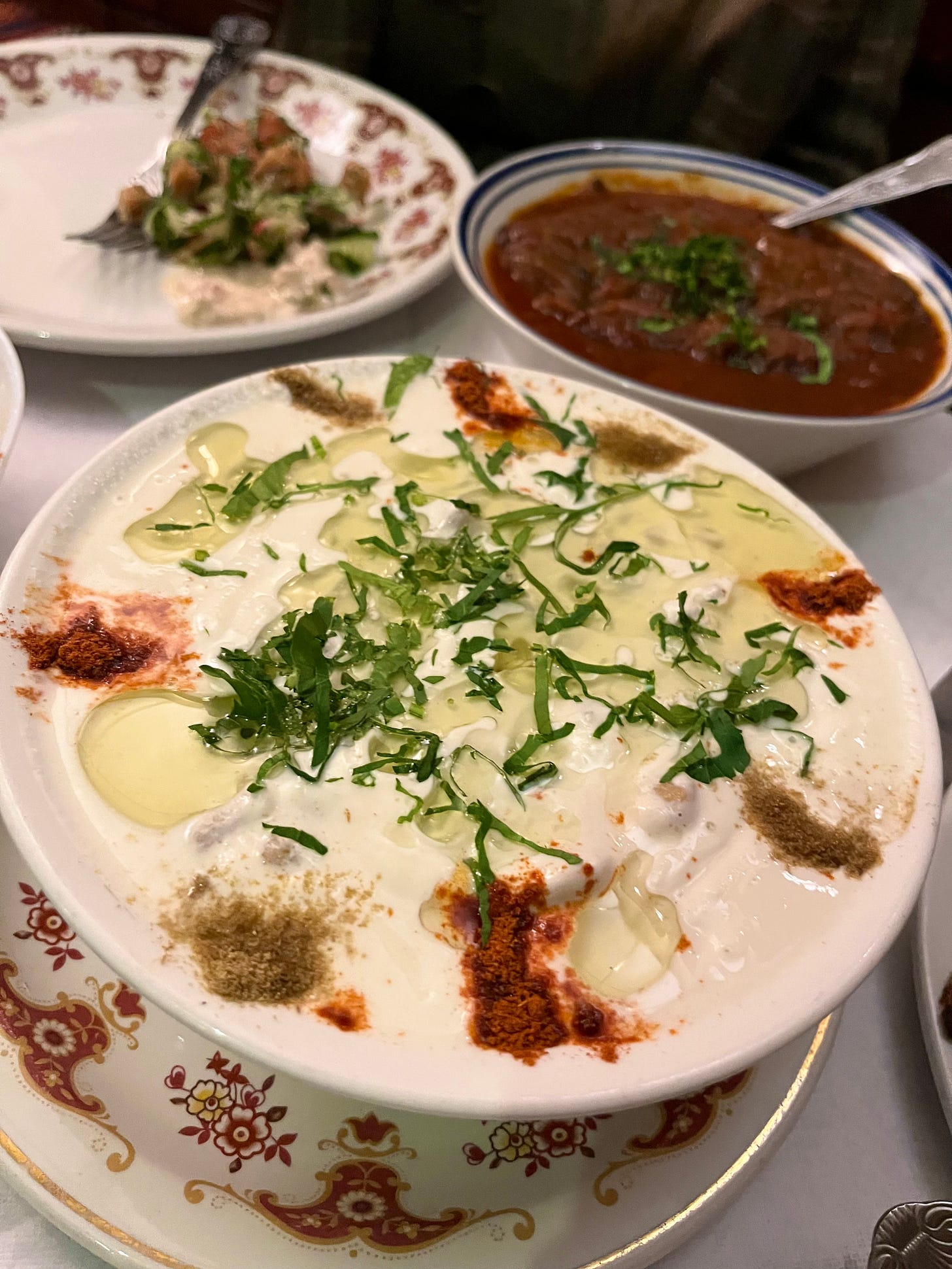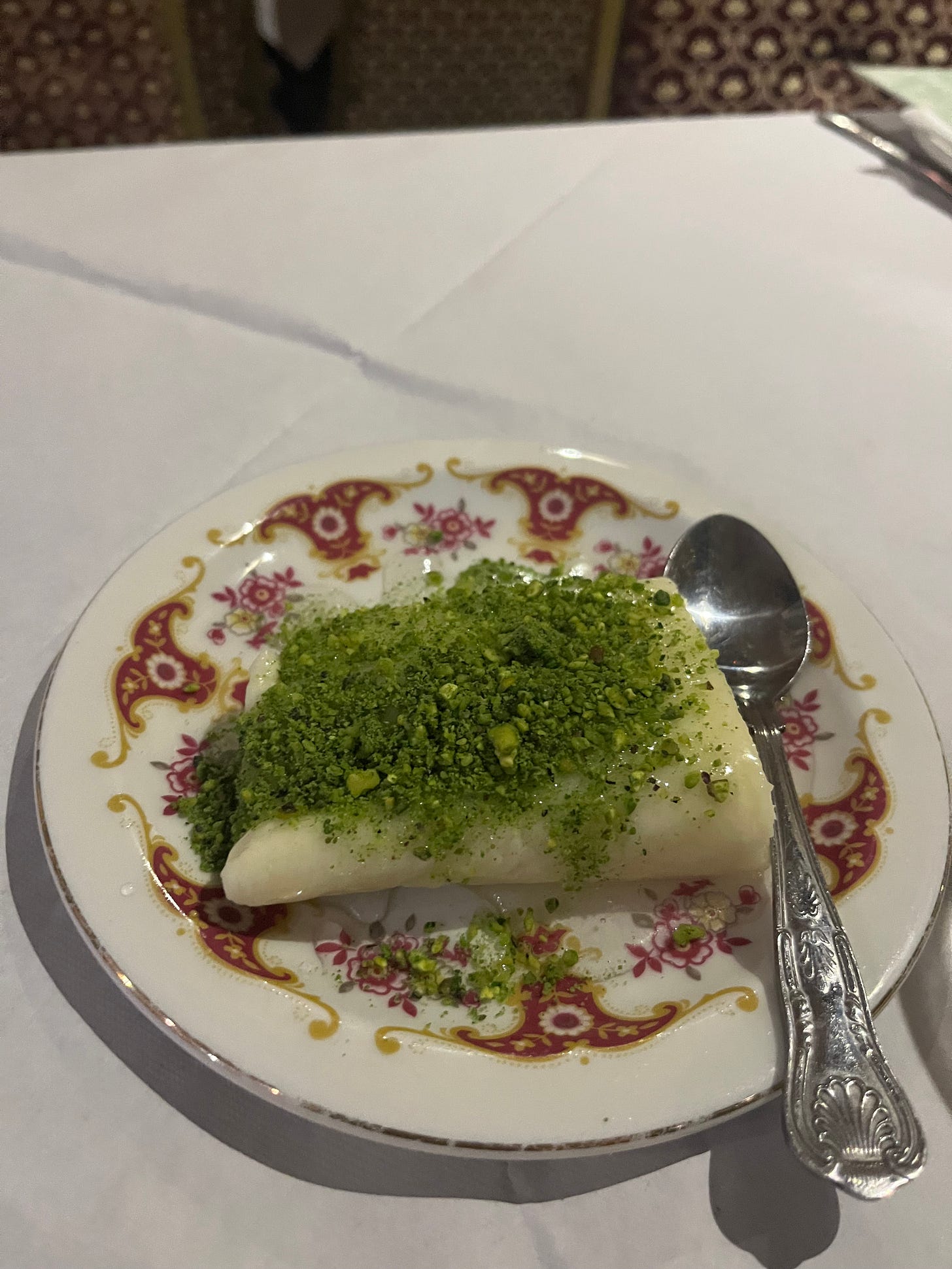From Aleppo To Manchester
Syrian restaurants in Manchester and their Jewish clientele. Words by Joel Hart.
This article is a part of Vittles British Jewish Food Week. To read the rest of the essays and guides in the project, please subscribe below:
From Aleppo to Manchester, by Joel Hart
Syrian restaurants in Manchester and their Jewish clientele
Aladdin is an institution, and institutions are famously, maybe necessarily, stubborn entities. In the last 30 years, many things have changed on Wilmslow Road — which stretches from the centre of the city, through Rusholme and its ‘Curry Mile’, to the south Manchester neighbourhood of Withington — but Aladdin is not one of them. Perhaps the prices could have been raised further (they have recently been slightly raised for the first time since 2005) but the fact that the restaurant’s interior has not changed since 1988 is something many regulars are grateful for. The tables are covered in ruby red, Islamic geometric-patterned tablecloths, the walls laminated with a cracked sandstone effect and decorated with black-and-white photos of early-20th-century Aleppo. All of it adds to the restaurant’s harlequin charm.
“People like it how it is,” current owner Ahmed al-Adin tells me. This applies to the food, too, with the most popular dishes including grilled lamb chops, kibbeh makli (deep-fried crushed bulgur wheat stuffed with spiced lamb and pine nuts) and mujaddara (a satisfying mix of cinnamon-laced rice, lentils and an ample topping of crispy fried onions). “It is the same consistency, no one feels the difference. I don’t trust any other chef. I have to do it all on my own.”
Arriving from Aleppo in 1989, al-Adin began working as a chef after learning how to cook traditional, Syrian dishes from his mother and took over the business in 2005. Not wanting anyone to miss Aladdin’s historical centrality in the story of Levantine/Middle Eastern restaurants in the city, al-Adin is eager to usher me over to the section of the restaurant walls displaying the first reviews of his restaurant in the Manchester Evening News from more than 30 years ago. One article from 1990 praised the restaurants with the heading reading “Aladdin’s Crave”.
Aladdin was once the only restaurant serving Arabic food in Manchester, and in the 30 years since it opened, it has given birth to the multiple iterations of Levantine restaurants in the city that have sprawled out from the south Manchester suburbs and into the rest of the city: from Pasha, also on Wilmslow Road, Jasmine, in nearby Chorlton, to Yara – which boasts multiple locations in the northern and southern suburbs – and Syriana in Hale Barns (the south Manchester suburb where I grew up) . These restaurants have lineage: Syriana’s owner Khaled al-Sabah is originally from Damascus and learnt his trade at Yara, which is owned by his brother who himself used to work at Aladdin.
Yet while the Arab population of Manchester has increased over the last few decades, the proliferation of these restaurants is in part a result of their most loyal clientele. As al-Sabah puts it, “This kind of food – Syrian food – has to be in a Jewish area in Manchester. We don’t rely on Syrian people, we rely on Jewish people.”
With 30,000 Jews living in the Greater Manchester area alone, the city has the second largest Jewish population in the UK. While some Jews arrived in Manchester in the 1750s, and another wave followed after the Napoleonic Wars in the early 19th century, the majority of today’s population descend from Ashkenazi Jews who fled European pogroms in the late 19th century. Most Ashkenazi Jews initially lived in Cheetham Hill/Crumpsall, around a 15-minute drive north from the city centre, but over the years moved to the further north suburbs of Prestwich and Whitefield, where the overwhelming majority of Jews who originally arrived in Manchester still reside today. In the 1970s, some began moving to Hale, in the market town of Altrincham, as well as to Hale Barns and Bowden where two synagogues have been established.
A smaller contingent of Sephardic Jews – which includes Jews from Syria – began emigrating to Manchester in the 1850s and continued to settle here due to their links in the textiles trade. In the 1950s there was a larger migration, with the response by many Arab states to the creation of the State of Israel leading to repressive conditions for Jews in Iraq, Syria and Egypt. The Syrian Jews of Manchester mostly came from Aleppo, while most of the Jews from Egyptian cities had origins in Aleppo, too. The Sephardic community was centred around the southern neighbourhood of Didsbury – directly south of Withington – until the 1990s, when the majority of families moved out to Cheadle, near Stockport, or also to the Altrincham area.
It was the Sephardic Jews of Didsbury who first frequented Aladdin when it opened as a restaurant in 1988. Jo Scorah (née Churba), whose mother’s parents and father’s father were from Aleppo, was one of them. Scorah lived in Didsbury until she was 14, and despite moving further out to the suburb of Cheadle, continued to eat at Aladdin for decades. She told me how on Saturday nights, the restaurant was mostly filled with Jewish people, often celebrating birthdays.
Scorah recalls, “My whole family was entrenched in Arabic and the Sephardic world, and while we did eat the same food at home, we had the money to go out. But also we were second generation, so we didn’t cook it in the same way. It is hard to make round fried kibbeh!”
According to al-Adin, even today most of Aladdin’s clientele are Jews. “They want to remember the food of their family. Most of them know me, it’s like coming home; they feel at home.” I enquired as to whether the relocation of a lot of the Jewish population further south may have meant less Jewish customers, but he insisted, “It’s more because most of the original customers are now very old, but now their children come.” For al-Sabah, it is important to be able to offer hospitality empowered by memories of a lost homeland. “Many are from the Middle East,” he tells me. “I have a customer called David who says the makdous [stuffed aubergine] reminds him of home.”
Taking pride in these restaurateur-customer relations may have something to do with Aleppo’s legacy as a multi-communal city, which was home to Armenians, Christians, Circassians and Kurds, in addition to Jews and Muslims. As a focal point of trade and a particularly diverse hub of Ottoman Syria, the city gained a reputation for its food and is still known today among Syrians as the country’s culinary capital. The city is no longer as diverse as it was, with almost all of the Jewish population gone by the 1970s and the Christian population – still 250,000 in 2010, 12% of the city’s population – reduced by 60% during the Syrian Civil War over the last decade. But the variegated traditions producing its culinary reputation still live on in the food. For example, itch, a local cooked bulgur salad using the same ingredients as tabbouleh, is often referred to as ‘Armenian tabbouleh’.
Yet the Aleppan identity of Aladdin may be lost on those without familial heritage in the city. Historically, it was not uncommon for Arab populations opening restaurants in the UK to label their cuisine ‘Mediterranean’. Later, ‘Lebanese’ and ‘Moroccan’ became acceptable, and many non-Lebanese Syrian restaurants would conform to the style of Lebanese menus. Aladdin still goes by ‘Arabic & Middle Eastern’, with Yara opting for ‘Lebanese and Syrian’ Only Syriana, the restaurant that opened most recently, displays the origins of the food in the name.
Aladdin, however, is still the most Syrian in its menu offerings. For the mezze, in addition to hummus, moutabal, babaganoush, labneh and makdous, it offers Syrian versions of hummus hab (whole boiled chickpeas with lemon) and fateh (chickpeas and pita chips in a yoghurt and tahini sauce), makmour (a rich tomato and aubergine stew), as well as the particularly Aleppan dishes of mutowameh (slowly stewed courgette cores), kibbeh safarjalieh (bulgur stuffed with lamb in a tomato sauce with quince) and kibbeh summakieh (bulgur stuffed with lamb in a tomato and sumac sauce). The majority of customers don’t know that al-Adin also used to work in a sweetshop in Aleppo, which is why the dessert menu is more extensive than Aladdin’s descendants. He is particularly proud of his halawet el-Jibn, which costs a reasonable £5. The balance of the dish is achieved through a lush texture, the subtly sour lactic hint in the cheese, the aromatic luxuriousness of the pistachio and the not-too-sweet sugar syrup tying it all together. It gives the version at London’s Levant Book Cafe a run for its money.
Whilst Yara and Syriana have departed from their ancestors’ offerings, dropping the mutowameh and focusing more on charcoal-grilled meats than Aleppan stew dishes, much of the formula remains the same, with some of the classic vegetarian dishes like the stuffed artichokes and the spinach stew developed at Aladdin. But more importantly, the connection between Muslim Syrian restaurateurs and a strong contingent of Jewish clientele has been maintained.
As the south Manchester suburbs have become a home to newly affluent populations, new groups of clientele have emerged. Al-Sabah tells me that although Manchester’s Syrian population generally don’t eat at his restaurant, given they don’t live locally, aren’t affluent enough to eat out regularly and prefer to eat Syrian food in a domestic setting, he now has a sizable number of Indian customers. Unlike the Jewish population – who often follow the rules of keeping kashrut at home – he caters many of their parties, and they always request that he add extra levels of spice and chili heat.
Many Ashkenazi Jews also frequent these restaurants. This is in part due to inter-marriage and greater mixing between Sephardic and Ashkenazi Jews of all denominations (particularly more secular Jews), but may also extend from the experience of eating Palestinian food in Jaffa or Mizrahi street food in Tel Aviv; experiences from which Ashkenazi Jews have developed a taste for and want to replicate in the UK. The other major shift of note in how Ashkenazi Jews eat at home is the adoption of Middle Eastern culinary elements. As I got older, in addition to chopped liver and egg-and-onion, hummus became the third variation of our Ritz cracker canapes, and then, in more recent years, I would find Ottolenghi salads alongside classic Friday-night roast chicken. My mother now eats weekly with a group of friends at Syriana, while a baharat gifted to her by al-Sabah has become a staple of the kitchen. On a recent visit to Aladdin, we ordered the Aleppan dish kibbeh sumakiyeh. The lamb was tender and falling apart in the headily tart and umami sumac-laced tomato sauce. My grandmother remarked on tasting it, “It’s what you call heimische; cooked forever, home-cooked.” We both chuckled.
Aladdin’s Sephardic Jewish customers may have waned slightly over the years due to intra-city migration but many still think of it as the best, and now Ashkenazi Jews who eat at Aladdin too think the same. Ironically, it is unlikely that Aleppo’s Jews would have eaten at restaurants very often due to kashrut laws, so few may have imagined that secularisation and their migration to Manchester would lead to the development of an emotional reciprocity between British-Syrian Jews and Muslims, cradled by the mnemonic power of food to evoke a sense of place.
Even if Aladdin’s non-Jewish customers dwindle, this connection seems here to stay. As al-Sabah tells me, “When I first opened Syriana, a Jewish customer said to me, ‘We will support you whatever happens. We will never let you close. We will keep coming here and keep you going.’”
Read more
A guide to Jewish food in Manchester - from cholent to amba coronation chicken
Where Has All the Tschulent Gone? - the changing tastes of orthodox Jewish Manchester
The Shop - How one Cypriot family preserved the London Jewish deli
Credits
Joel Hart is an urban anthropologist and food & drinks writer. You can find him on Instagram or at The Schmaltz, where he has recently embarked on a writing project on Ashkenazi-Jewish foodways.
Vittles British-Jewish Food Week is edited by Molly Pepper Steemson, with additional editing from Jonathan Nunn and Adam Coghlan, and subediting by Sophie Whitehead and Liz Tray.
All illustrations are by Georgia Turner, a freelance illustrator and neuroscience PhD student from London.

